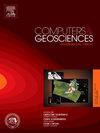基于改进型密集卷积网络的二维磁图谱深度学习反演方法
IF 4.2
2区 地球科学
Q1 COMPUTER SCIENCE, INTERDISCIPLINARY APPLICATIONS
引用次数: 0
摘要
磁电反演(MT)是MT数据解释的重要手段。利用深度学习技术进行MT反演因其不局限于初始模型、避免陷入局部最优解以及处理海量数据的强大能力而备受关注。然而,如何获得高度可靠的深度学习反演结果仍是一个挑战。本文提出了一种基于改进型密集卷积网络(DenseNet)的二维(2-D)MT反演方法,旨在提高二维深度学习MT反演结果的可靠性。首先,在建立样本集时,使用 MARE2DEM 计算二维 MT 前向响应。然后,通过在密集连接块中采用深度可分离卷积代替标准卷积,并嵌入注意力机制,提出了改进的 DenseNet。深度可分离卷积将标准卷积操作分为深度卷积和点卷积,从而有效捕捉输入数据的空间特征和通道之间的相关性。同时,注意力机制允许网络对数据序列中的不同元素赋予不同程度的重要性(或注意力),从而增强了关键特征提取能力。这种设计不仅保留了 DenseNet 固有的特征重用功能,缓解了 DenseNet 的梯度消失问题,还进一步提高了网络性能。改进后的 DenseNet 的优化网络参数通过在训练集上的训练获得,而验证集则用于调整超参数和评估模型性能。最后,利用合成数据和现场数据对所提出的二维深度学习方法进行了验证。合成数据的实验结果表明,使用所提算法得到的反演结果的可靠性得到了提高,使用 TE 和 TM 模式数据得到的反演结果比使用单一模式数据得到的反演结果更准确。野外数据反演结果表明,所提出的二维 MT 深度学习反演方法能有效探测地下电阻率结构,具有良好的应用前景。本文章由计算机程序翻译,如有差异,请以英文原文为准。
A two-dimensional magnetotelluric deep learning inversion approach based on improved Dense Convolutional Network
Magnetotelluric (MT) inversion is an important means of MT data interpretation. The use of deep learning technology for MT inversion has attracted much attention because it is not limited to the initial model, avoids falling into local optimal solutions, and has the strong ability to process large amounts of data. However, obtaining highly reliable deep learning inversion results remains a challenge. In this paper, we have proposed a two-dimensional (2-D) MT inversion method based on the improved Dense Convolutional Network (DenseNet), with the aim of improving the reliability of the 2-D deep learning MT inversion results. First, the MARE2DEM is used to compute the 2-D MT forward responses when establishing the sample set. Then, an improved DenseNet is proposed by incorporating depthwise separable convolution in lieu of standard convolution within dense connection blocks, and embedding the attention mechanism. Depthwise separable convolution splits the standard convolution operation into depthwise and pointwise convolution, effectively capturing spatial features of input data and correlations between channels. Meanwhile, attention mechanism allows the network to assign varying degrees of importance (or attention) to different elements in a sequence of data, thus enhancing its ability of key feature extraction. This design not only retains the inherent feature reuse and alleviates gradient vanishing of DenseNet but also further enhances network performance. The optimized network parameters for the improved DenseNet are obtained by training on the training set, while the validation set is used to adjust hyperparameters and evaluate model performance. Finally, the proposed 2-D deep learning approach is verified by using both synthetic and field data. Experimental results with synthetic data show that the reliability of inversion results obtained by using the proposed algorithm is improved, and the inversion results obtained by using both TE- and TM-mode data is more accurate than those obtained by using the single mode data. The inversion results of field data show that the proposed 2-D MT deep learning inversion approach can effectively detect the subsurface resistivity structure and has a good application prospect.
求助全文
通过发布文献求助,成功后即可免费获取论文全文。
去求助
来源期刊

Computers & Geosciences
地学-地球科学综合
CiteScore
9.30
自引率
6.80%
发文量
164
审稿时长
3.4 months
期刊介绍:
Computers & Geosciences publishes high impact, original research at the interface between Computer Sciences and Geosciences. Publications should apply modern computer science paradigms, whether computational or informatics-based, to address problems in the geosciences.
 求助内容:
求助内容: 应助结果提醒方式:
应助结果提醒方式:


